

Pennsylvania Department of Environmental Protection
Welcome!
The mission of the Pennsylvania Department of Environmental Protection (DEP) is to protect Pennsylvania’s air, land and water from pollution and provide for the
health and safety of its citizens through a cleaner environment. We work as partners with individuals, organizations, governments and businesses to prevent pollution
and restore our natural resources. This annual report presents trends in Pennsylvania's oil and gas industry. For more detailed information, visit the DEP
Oil and Gas Program website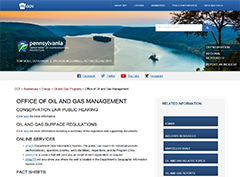
To view the report, simply scroll down or use the top menu to jump to a topic. If content doesn’t display properly, please try opening the report using another web browser.
Disclaimer: The information contained in this report is based on the data contained in DEP information systems at the time of the publication of this report, including, but not limited to, DEP's enterprise-wide permitting and compliance database called eFACTS (Environment Facility Application Compliance Tracking System). As some data contained in these systems are self-reported by operators and other permitees, data in this report reflects the data as reported to the department.
Message From the Secretary
The DEP Office of Oil and Gas Management administers an internationally recognized oil and gas program that includes the Bureau of Oil and Gas Planning and Program Management and the Bureau of District Oil and Gas Operations.
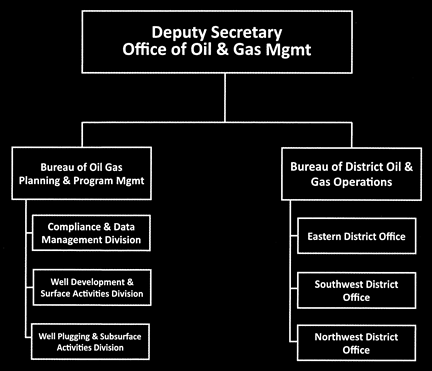
The Bureau of Oil and Gas Planning and Program Management is located in Harrisburg and is responsible for administrative, policy, technical assistance and regulatory development functions. The Bureau of District Oil and Gas Operations consists of three district oil and gas offices and is responsible for permitting, inspection, compliance and enforcement functions.
See the “2017 Calendar” to view a complete detailing of accomplishments by month.
Before an operator may begin drilling a well, it must first submit the proper permit applications to DEP for review and approval. Different types of permits are related to oil and gas activities including, but not limited to:
2,028 - Unconventional well drilling permits issued in 2017.
203 - Conventional well drilling permits issued in 2017.
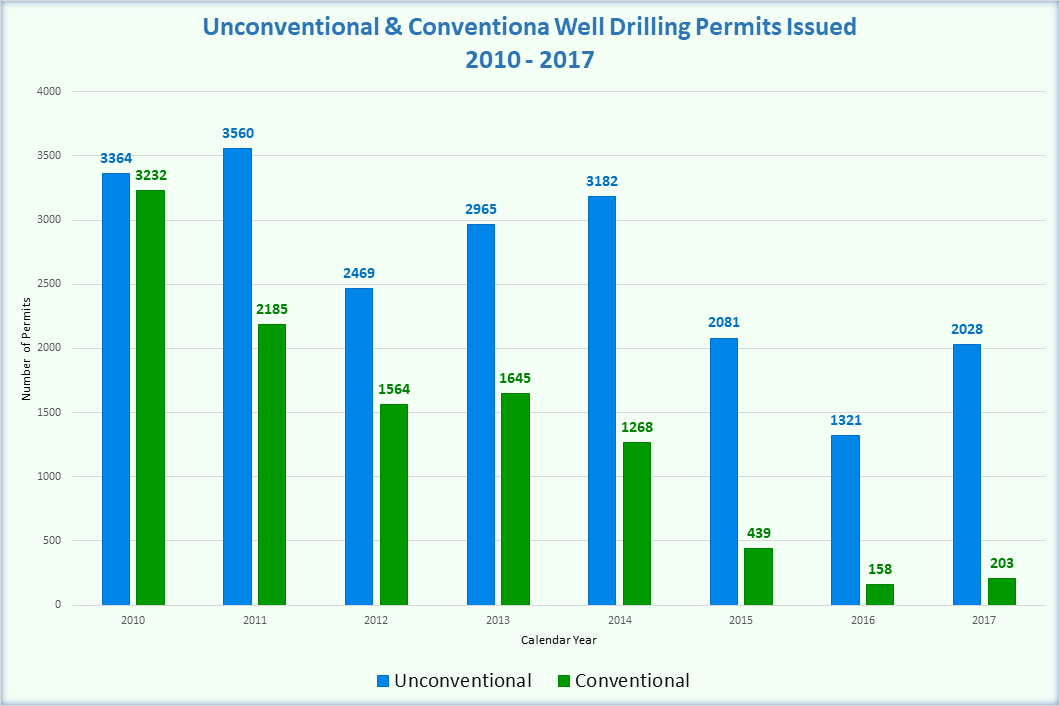
In 2017, DEP began developing a new ePermitting application to replace the old “eWell” system and streamline the permit process. The new ePermitting application is expected to be released in late 2018.
DEP inspects oil and gas well sites to ensure they are constructed and operated in accordance with approved permits. DEP’s goal is to inspect new wells at the beginning, middle and end of construction and development. Inspections increased about 2 percent from 2016 to 2017, due in part to efficiencies gained from the development of electronic permitting capabilities. DEP has also increased emphasis on inspecting orphan and abandoned wells.
36,288 - Number of compliance inspections conducted in 2017.
The number of compliance inspections has significantly increased from 2010 through 2017. In 2010, oil and gas inspectors conducted a total of 16,504 inspections and this number rose to 36,288 inspections in 2017; more than twice as many inspections.
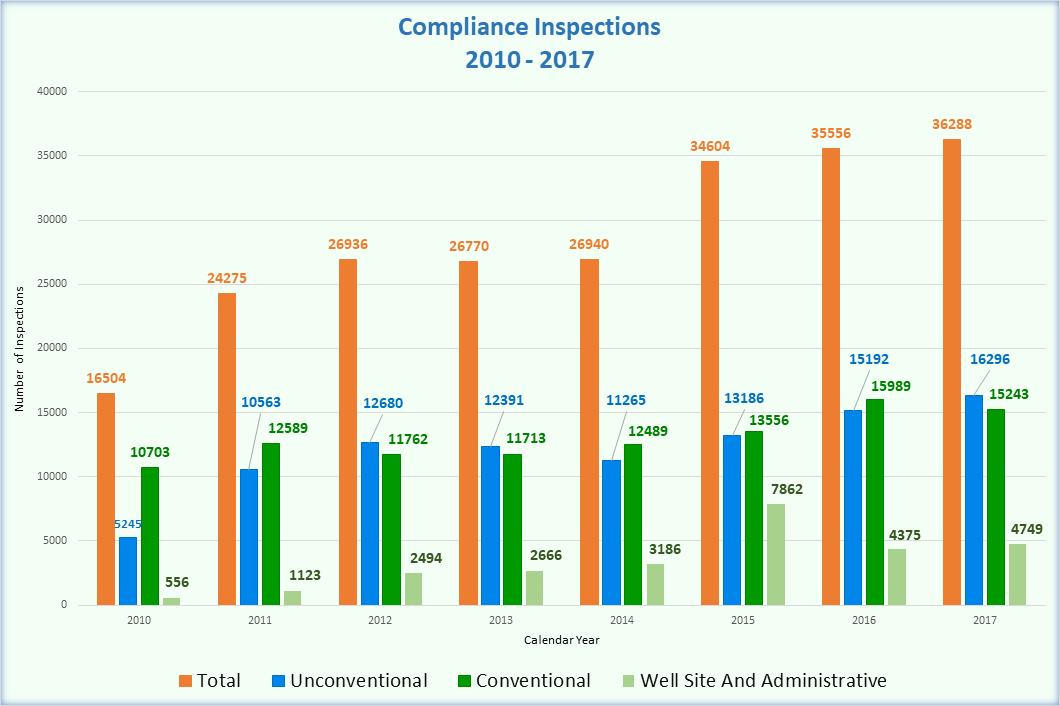
DEP is committed to working with oil and gas operators to ensure well sites operate in compliance with all applicable laws and regulations. DEP routinely provides compliance assistance through outreach and training opportunities. The total number of conventional well violations increased from 1,834 in 2016 to 3,273 in 2017. Unconventional well violations increased from 456 in 2016 to 821 in 2017.
DEP’s compliance and enforcement tracking database (eFACTS) was updated in 2017 to record an ongoing violation that is not otherwise corrected prior to a subsequent inspection as a separate violation. Therefore, DEP now has the ability to record multiple violations for the same incident if it is not corrected in a timely manner.
To view all conventional and unconventional well violations from 2017, click here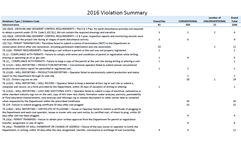 .
.
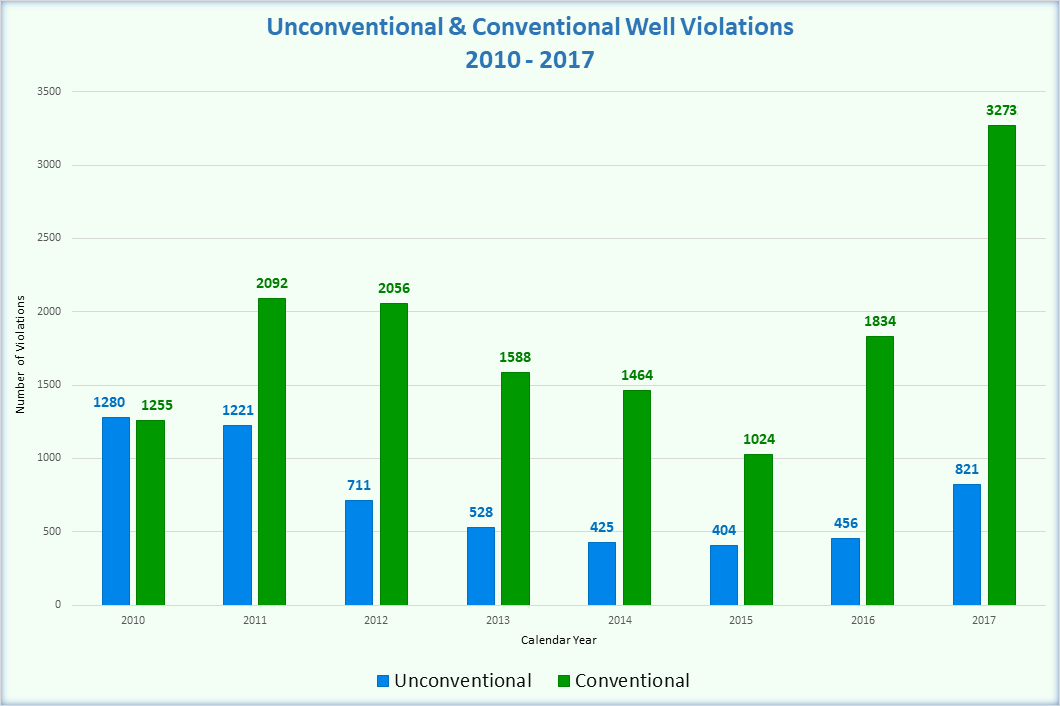
Since 2010, DEP has collected about $35.5 million as a result of noncompliance at oil and gas sites in Pennsylvania. These fines and penalties are used to reimburse operating costs that are incurred by DEP in the oversight of oil and gas and related environmental programs.
$3,540,777 - Total fines and penalties collected in 2017.
The fines and penalties collected in calendar years 2014 and 2016 are a result of significant violations observed at a relatively small number of enforcement actions. For example, in 2016, nine violations resulted in the levy of about $8.4 million of the $9.7 million collected that year.
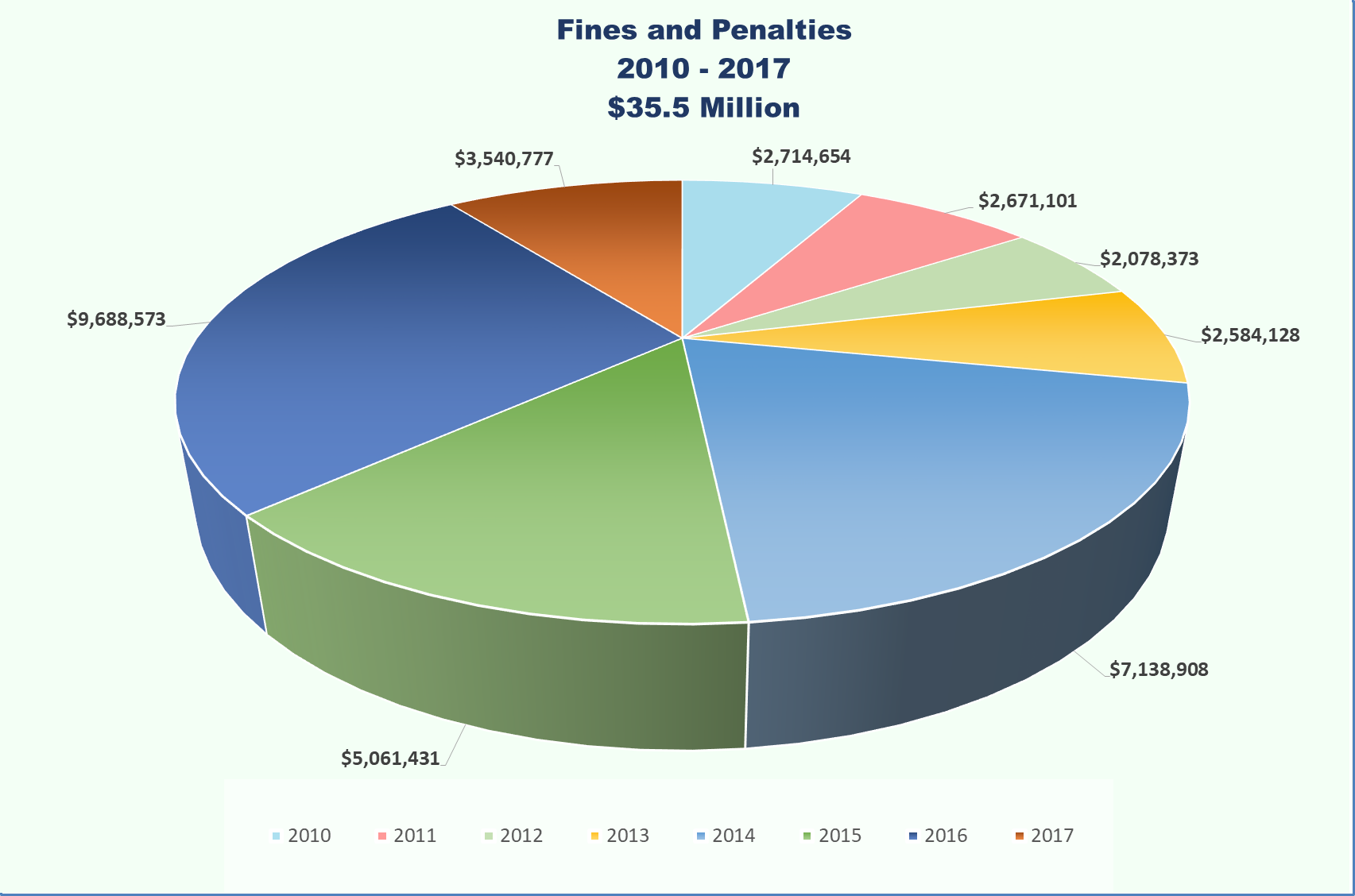
Legacy Well Identification
As a result of the oil and gas drilling booms during the mid-nineteenth and early twentieth centuries,
hundreds of thousands of oil and gas wells were drilled in Pennsylvania. Over the past 150 years, many of these wells were abandoned by their owners without notifying DEP or other state
agencies. DEP estimates that between 100,000 and 560,000 abandoned oil and gas wells exist in Pennsylvania that remain unaccounted for. These legacy orphan and abandoned wells can lead to
pollution if they are not properly plugged.
DEP has located 11,359*orphan and abandoned wells and is working diligently to identify the location of the many remaining wells.
Unfortunately, given its current resources, it will likely take DEP many years to locate all of Pennsylvania’s legacy wells.
*Unplugged orphan/abandoned wells = 8,287 (source: DEP eFACTS database). Plugged orphan/abandoned wells = 3,072 (source: well plugging certificates from
contracts issued)
One way the public and industry can help DEP to expand its inventory of known legacy wells is to report the location of such wells when they are discovered. If you come across a well on your property or when you are on other public lands that you believe is an orphan or abandoned well, please let DEP know. Contact a DEP District Oil and Gas representative at the telephone number listed in the below Fact Sheet.
Click on the play button above to view the slideshow of abandoned oil and gas wells.
Good Samaritan Legacy Well Cleanups
DEP developed an initiative in 2017 to encourage private-sector partners to become Good Samaritans, by participating in a program that helps to plug dangerous abandoned oil and gas
wells statewide. The program protects third-parties from liability for their role in helping to reduce the health, safety, and environmental hazards associated with the plugging of
orphan and abandoned wells.
The Environmental Good Samaritan Act of 1999 protects groups and individuals who volunteer to implement qualifying environmental remediation projects from civil and environmental liability. The Act does not provide immunity for injury or damage that may result from reckless, unlawful, or grossly negligent acts or omissions.
While the Act has been used in the past to encourage mine reclamation projects, DEP applied its provisions to two oil and gas well plugging projects for the first time in 2017.
A
volunteered to plug a well in Warren County that was discharging crude oil to the ground and nearby streams.
An
volunteered to plug a leaking natural gas well in Elk County. These projects are estimated to have saved DEP $60,000 to $85,000, in addition to
administrative cost savings related to contract development and management.
Additional project proposals are currently under review and DEP welcomes other third parties to step forward to take advantage of the benefits of participating in the Good Samaritan Legacy Well Cleanup initiative. Not only will they enjoy reduced liability, but they may often develop the land at or near the well site more quickly than waiting for state funding to become available for the plugging project.
DEP has developed online
training

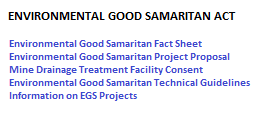
Questions about well plugging through the Environmental Good Samaritan Act can be addressed to the DEP’s
Bureau of Oil and Gas Planning and Program Management or the district office where the project is located
![]() .
.
Legacy Well Initiatives and Partnerships
When no viable responsible party can be identified for an orphan or abandoned oil or gas well, the DEP Well Plugging Program has authority to address proper plugging of the well.
Funding to address legacy wells comes from surcharges established by the 1984 Oil and Gas Act of $150 and $250, respectively, for each oil well permit and gas well permit. Because DEP has received a reduced number of permits in recent years, fewer funds are available to plug orphan and abandoned wells in Pennsylvania.
Currently, more abandoned wells are being added to the state’s inventory than are being addressed through permanent plugging through state-issued contracts. Since 2015, DEP has been able to fund the plugging of oil and gas wells only in emergency situations and/or when residents must be temporarily evacuated from their homes due to imminent threats that legacy wells pose when well integrity is compromised.
Legacy oil and gas wells are one of the most significant environmental challenges facing the commonwealth. By assessing historic operating costs and acknowledging the sheer number of wells, DEP estimates that addressing legacy wells will require $150 million to $3.7 billion. The low end of this estimate assumes that DEP will not identify any additional abandoned wells; the upper end of the estimate assumes about 200,000 legacy wells will eventually be identified and plugged.
Starting in 2015, DEP increased its efforts to address the challenges posed by legacy wells in Pennsylvania. The groundwork for the effort was largely established in 2016 and in
2017 many successes were realized. DEP’s efforts consisted of several key components that include:
This work ultimately extended far beyond the DEP Office of Oil and Gas Management, and the effort exemplifies a collaborative assimilation and implementation of ideas and procedures that have saved or secured millions of dollars for the commonwealth, while introducing marked improvements in efficiency. The following table presents in-kind contributions and cost savings that have helped to leverage additional dollars to plug legacy wells in Pennsylvania.
| Project/External Funding | Savings/Contributions |
|---|---|
| Estimated cost savings: Abandoned well no. 003-01011 | $1,000,000 |
| Estimated cost saving: Abandoned well no. 003-22455 | $10,000 |
| Environmental Stewardship Funds secured | $460,000 |
| Estimated cost savings: Abandoned well no. 125-21401 | $179,000 |
| Estimated cost savings: DCNR Cooks Run well | $190,000 |
| CFA 2017 grants awarded | $657,503 |
| CFA 2016 grants awarded | $130,000 |
| Estimated cost savings: Good Samaritan | $85,000 |
| Cost savings: Turnpike Commission plugging project | $3,500,000 |
| TOTAL | $6,211,503 |
What We Accomplished in 2017
Click on a calendar month below to view detailed accomplishments.












Where are Pennsylvania’s oil and natural gas reserves located?
The nation’s first oil well was drilled in 1859 by Edwin Drake in Titusville, PA. Today, most oil in Pennsylvania is produced in the northwest corner of the state. This area is commonly called the oil patch since it is home to the largest number of active oil wells.

Pennsylvania's Shale Plays
In 2004, operators began producing natural gas from the Marcellus shale formation which extends from the southwest to northeast corners of the state. There are other shale formations in the state, such as the Utica shale formation, that contain substantial reserves of natural gas. Pennsylvania’s shale formations are expected to produce natural gas for many decades into the future.
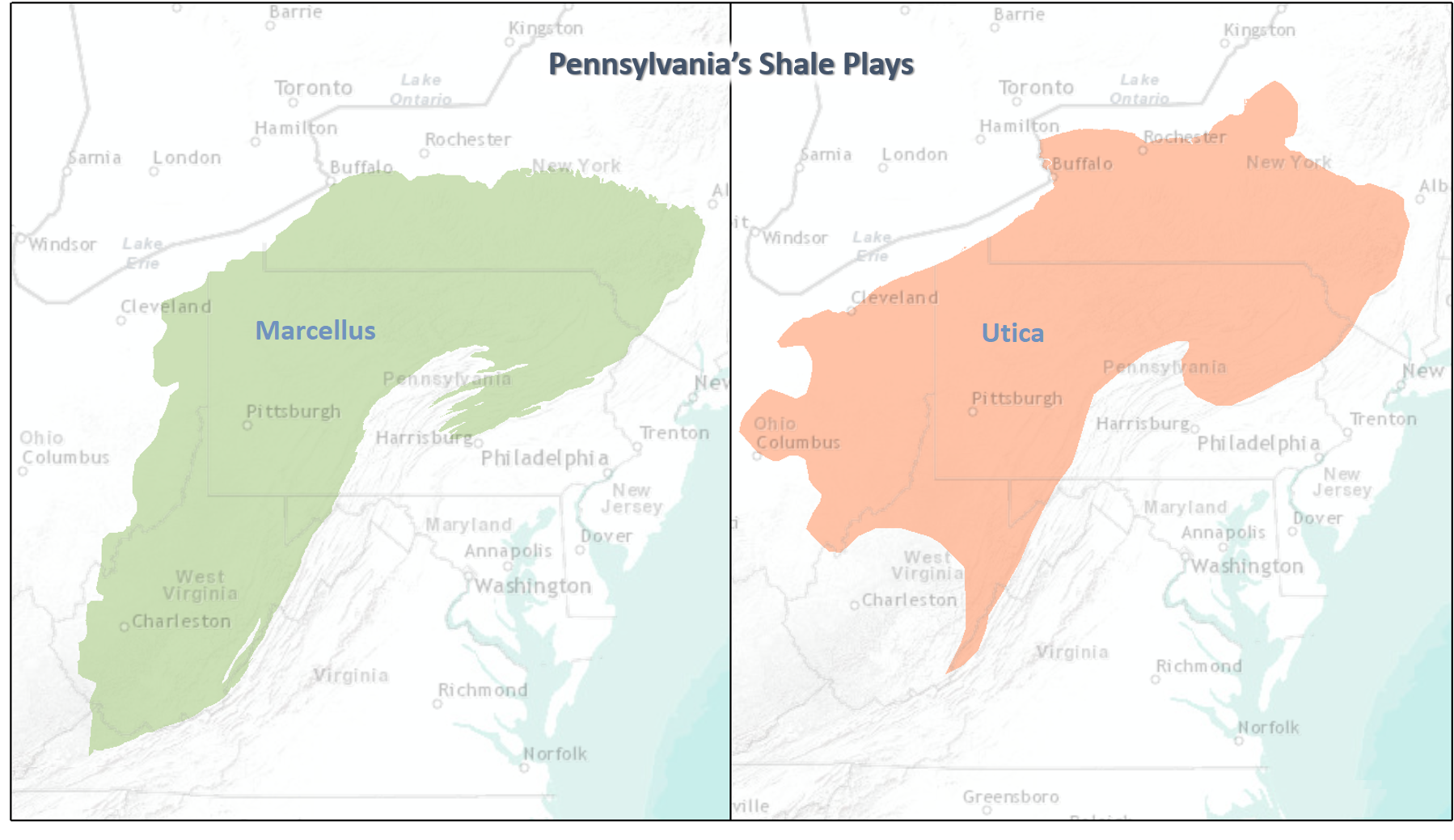
What is a Conventional vs. an Unconventional Well?
Conventional Wells
A conventional well is typically a well that is drilled vertically into a shallow oil or gas reservoir.
Conventional wells are constructed on much smaller well pad sites than unconventional wells. Most conventional wells do not require large volumes of water for hydraulic fracturing and do not employ horizontal drilling techniques. In Pennsylvania, what constitutes a conventional well is defined by law in Act 52 of 2016 and 25 Pa. Code Chapter 78.
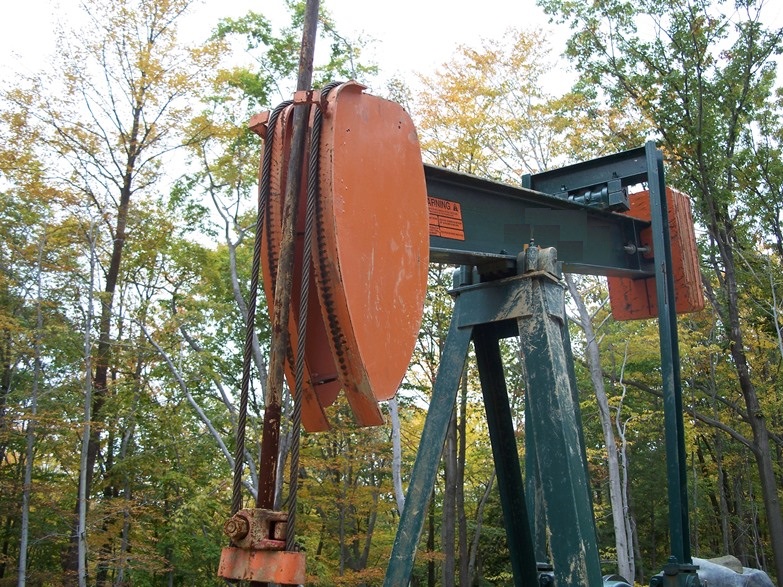
Unconventional Wells
An unconventional well generally refers to a well that is drilled deep into shale formations to produce natural gas. A distinction of these wells is that they
involve horizontal drilling techniques and use large volumes of water under high pressures to hydraulically fracture (commonly called “fracking”) the shale rock to access
large volumes of natural gas. In Pennsylvania, what constitutes an unconventional well is defined by law in Section 3202 of the 2012 Oil and Gas Act and 25 Pa. Code Chapter
78a.
Where Are Oil and Gas Wells in Pennsylvania?
Shown to the right are thumbnail images of the conventional, unconventional and Utica and Point Pleasant wells drilled by county. For a high-level
view of where conventional oil and gas wells were drilled during calendar year 2017, click on any map to view a larger interactive version. Wells
drilled in 2017 appear as "squares" and wells drilled prior to 2017 appear as "circles". The Utica/Point Pleasant map depicts only those wells drilled
in 2017.
DEP developed an interactive GIS mapping tool that can be used to identify oil and gas wells that are located
in Pennsylvania. In addition to specific well locations, this tool provides other information including production data, inspection results and
compliance actions taken by DEP, and more. To learn about this tool, check out the
tutorial![]() and begin using this
interactive map today
and begin using this
interactive map today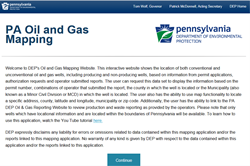 . To see the trend in the number of wells
drilled from 2010 through 2017, click the button below the interactive maps.
. To see the trend in the number of wells
drilled from 2010 through 2017, click the button below the interactive maps.
What is a Class II Underground Injection Control (UIC) Disposal Well?
A Class II UIC disposal well is used to dispose of produced fluids (i.e., brine fluids) that flow back to the surface after a well is hydraulically fractured. In 2017, about 94
percent of all produced fluids was recycled and/or reused in the production/hydraulic fracturing of other natural gas wells and about 6 percent was disposed in Class II disposal wells.
The U.S. Environmental Protection Agency is responsible for reviewing and approving Class II UIC well permit applications in Pennsylvania. However, DEP also conducts a review of these permit applications to ensure state regulatory requirements are met prior to issuing a permit for well usage.
DEP’s permit review involves a review of the Control and Disposal Plan, Erosion and Sedimentation Control Plan, Casing and Cementing Plan, Geologic Analysis and Mechanical Integrity Analysis to ensure the well can accept the produced fluid at proposed rates and pressures.
Where Are UIC Class II Disposal Wells in Pennsylvania?
Currently, there are 12 active UIC Class II disposal wells located in Pennsylvania.
The CNX Gas Co., LLC UIC Class II disposal well listed below is in the process of being permanently plugged.
| Operator | Permit Status | Municipality | County | |
|---|---|---|---|---|
| 1 | Bear Lake Properties, LLC | Active | Columbus Township | Warren |
| 2 | Bear Lake Properties, LLC | Active | Columbus Township | Warren |
| 3 | Bear Lake Properties, LLC | Active | Columbus Township | Warren |
| 4 | CNX Gas Co., LLC | Active | Jenner Township | Somerset |
| 5 | Columbia Gas of PA, Inc. | Active | South Beaver Township | Beaver |
| 6 | LPR, Inc.* | Active | Stonycreek Township | Somerset |
| 7 | EXCO Resources PA, LLC | Active | Bell Township | Clearfield |
| 8 | Pennsylvania General Energy | Active | Grant Township | Indiana |
| 9 | Sammy-Mar, LLC | Active | Huston Township | Clearfield |
| 10 | Seneca Resources Corp | Active | Highland Township | Elk |
| 11 | Stonehaven Energy Mgmt Co., LLC | Active | Cranberry Township | Venango |
| 12 | Windfall Oil & Gas, Inc.** | Active | Brady Township | Clearfield |
Neighboring states contain many more active UIC Class II disposal wells compared to Pennsylvania. For example, Ohio has more than 200 and
West Virginia has more than 40 active UIC disposal wells, respectively. Most produced fluids from Pennsylvania that are disposed in UIC Class II disposal wells are transported to
neighboring states. To view waste production reports by operator, county or waste facility click
here
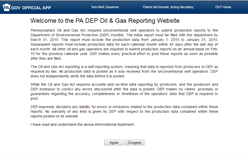
How Much Natural Gas is Produced in Pennsylvania?
Although natural gas has been produced for many years using conventional drilling methods, it was not until 2004
that the first unconventional natural gas well was drilled in Pennsylvania’s Marcellus Shale play. It did not take long before natural gas operators began exploring and producing large amounts of natural gas from the Marcellus Shale play and other
shale plays.
The volume of natural gas recovered from Pennsylvania’s shale plays has steadily increased since the first natural gas well was drilled in Pennsylvania; and much more natural gas remains available for future exploration and development.
In 2017, about 5.36 trillion cubic feet of natural gas was produced from unconventional gas wells in Pennsylvania. This represents the largest volume of natural gas on record that has been produced in Pennsylvania in a single year.
Currently, Pennsylvania is the second largest producer of natural gas in the nation (Texas produces the most).
To query production information related to natural gas, condensate, oil and waste for each permitted well,
click here
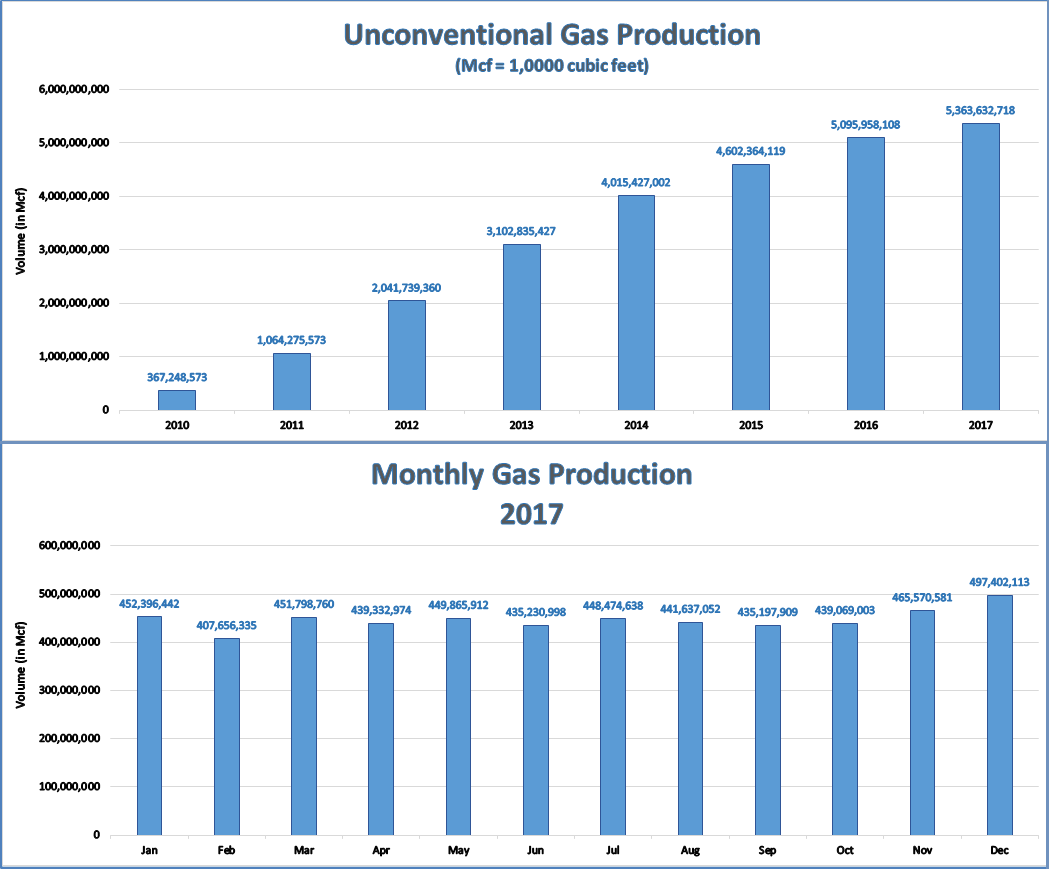
Are there Natural Gas Storage Reservoirs in Pennsylvania?
Natural gas is a commodity that is used in the residential, commercial, industrial and transportation sectors for activities such as space heating, water heating, combined heat and power, cooking, drying, and is a
feedstock in the production of fertilizers and plastics.
Since most natural gas is used as a fuel source to heat homes and businesses, the demand for natural gas peaks in winter months. In the summer, natural gas producers routinely store gas in geologic reservoirs for future use during the colder seasons of the year.
Three types of natural gas reservoirs are most commonly used in the United States. First, historic natural gas reservoirs that were depleted of its natural gas supplies are the most common geologic features that are suitable to be put back into productive use as reservoirs to store natural gas from other active natural gas producing formations. Second, natural gas may be injected into a subsurface geologic formation to displace water from the pore space and this is called an “aquifer” reservoir. Finally, salt caverns that are created by flushing out salts from solid salt domes or formations are sometimes used as a natural gas storage feature.
According to a study conducted by the American Petroleum Institute in June 2017, Pennsylvania has the fourth largest total capacity to store natural gas in geologic formations in the nation.
In November 2017, the DEP Oil and Gas Program developed a statewide protocol for assessing and verifying the mechanical integrity of underground natural gas storage reservoirs in Pennsylvania. The protocol is used by Oil and Gas staff to ensure that natural gas storage reservoirs are operated in a safe and reliable manner to ensure the protection of Pennsylvania’s environment and the safety of its citizens.
What Happens When a Well Stops Producing Oil or Gas?
Eventually, active oil and gas wells stop producing oil and gas or become uneconomical to operate. When Pennsylvania’s
Oil and Gas Act of 1984 was enacted, regulations were created to require the plugging of such wells. Although operators are required to post bonds with DEP to ensure that wells are properly plugged at the end of their useful life,
this was not always the case. Legacy oil and gas wells are discussed in more detail in the section of this report called “Plug Legacy Wells”.
DEP has spent over $34 million since 1989 to administer Pennsylvania’s orphan and abandoned oil and gas well program, but much work remains. DEP collects a small surcharge on each well drilling permit to plug unsafe orphan and abandoned wells and DEP’s Growing Greener grant program has funded more than $13 million toward well plugging projects over the history of the program. In 2016 DEP spent $1,029,166 to plug 23 wells and in 2017 DEP spent $1,093,598 to plug 7 wells.
Given the estimated hundreds of thousands of orphan and abandoned oil and gas wells that may exist in Pennsylvania, there is not enough funding currently available to plug the remaining wells. Unless additional monies are identified for this purpose, the universe of orphan and abandoned wells will remain unplugged and will be a potential environmental and safety threat for many decades to come.
Can I Review Forms and Reports that DEP Receives from Unconventional Oil and Gas Operators?
Yes. Pennsylvania’s oil and gas regulations require unconventional operators to submit to DEP electronically various forms, requests and reports such as completion
reports and well records.
DEP developed a search tool called "eSubmissions" to allow the public to view the forms and reports that are submitted to DEP electronically. To view this search tool, go
here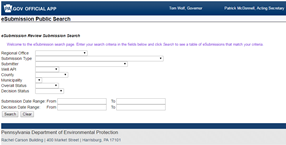
Can I Review Notifications that DEP Receives from Oil and Gas Operators?
Yes. All oil and gas well operators are required to submit advanced notification to DEP electronically the date it starts to drill a well (aka, “spud date”). Additionally,
operators of unconventional wells are required to electronically notify DEP in advance of conducting various operations such as casing and cementing a well, hydraulically
fracturing a well and abandoning or plugging a well.
To review the spud notifications report, go
here
DEP’s Greenport application allows DEP to receive new notifications required by the promulgation of 25 Pa. Code Chapter 78a. To view the "eNotifications" report, go
here
Where Can I Access Online Reports?
DEP has developed many useful interactive reports to enable the public to quickly search DEP’s databases.
The reports include the ability to view oil and gas permits that have been issued, locations of wells that are drilled, locations of orphan and abandoned wells and natural gas production reports to name a few. Visit DEP’s
website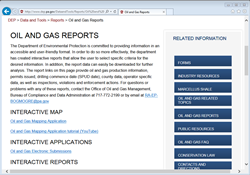
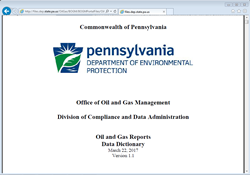
Webinars and Oil and Gas Technical Advisory Board
The public may attend regular meetings of the Oil and Gas Technical Advisory Board (TAB) and Pennsylvania Grade Crude Development Advisory Council (CDAC). These meetings routinely
involve discussions about proposed oil and gas regulations, policies and other related topics. Generally, CDAC focuses on issues that pertain solely to the conventional oil and
gas industry and TAB examines issues that pertain mainly to the unconventional industry, but sometimes considers issues related to the conventional industry.
To view meeting dates and locations for CDAC, go to the Department of Community and Economic Development's (DCED) webpage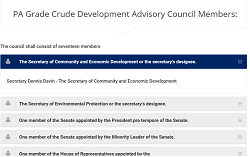
To attend a TAB meeting via WebEx, go here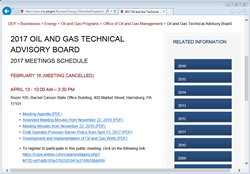
DEP’s Office of Oil and Gas Management periodically offers stakeholders and the public opportunities to participate in Webinars regarding other general oil and gas topics.
To view prior webinars, here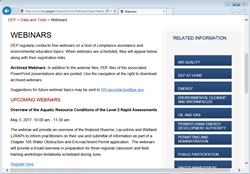
eComment
DEP encourages the public to provide constructive comments about regulations, policies, technical guidance, general permits, and other proposals that are under development.
To access the full text of such documents, submit comments, and see comments from other individuals, please visit the DEP website
here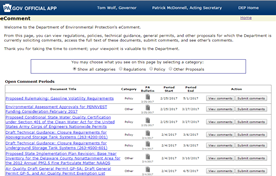
eNotice
DEP developed an electronic notification system for the public to use to stay up-to-date with many types of environmental topics. This tool is called eNOTICE and you may
register to receive free notifications of important actions the department takes. It’s easy. Go here 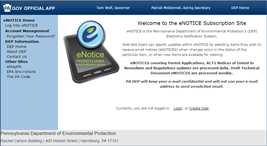
DEP Newsletter
DEP publishes a biweekly newsletter that features information about hot topics, recent department actions, regulatory updates, webinars and upcoming events. To subscribe
to this free newsletter, click
here
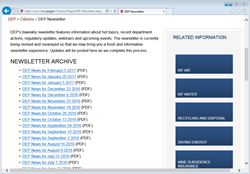
Water Supply Impacts
DEP is committed to the protection of environmental resources including private water supplies. The Oil and Gas Act of 2012 (Act) contains language that holds oil and gas operators
responsible for restoring or replacing water supplies when it is determined that oil and gas activities are the cause of contamination. The Act goes a step further and presumes
that an oil and gas operator is responsible for contamination of water supplies located within prescribed distances and timeframes; unless the operator can clearly demonstrate that
it is not responsible for the contamination.
Although there is no evidence that hydraulic fracturing has resulted in a direct impact to a water supply in Pennsylvania, there are cases where related oil and gas activities have adversely affected private water supplies. DEP investigates all stray gas-related complaints and if it is determined that a water supply is adversely affected by oil and gas activities, DEP works with the responsible operator to ensure the water supply is restored or replaced.
Contact Us...
To report any cases of suspected water contamination that may be associated with the development of oil and gas resources or any other environmental complaint, call DEP’s statewide
environmental hotline at 1-866-255-5158.
To report an environmental emergency to DEP, click on the button below, and call the appropriate regional emergency contact number.
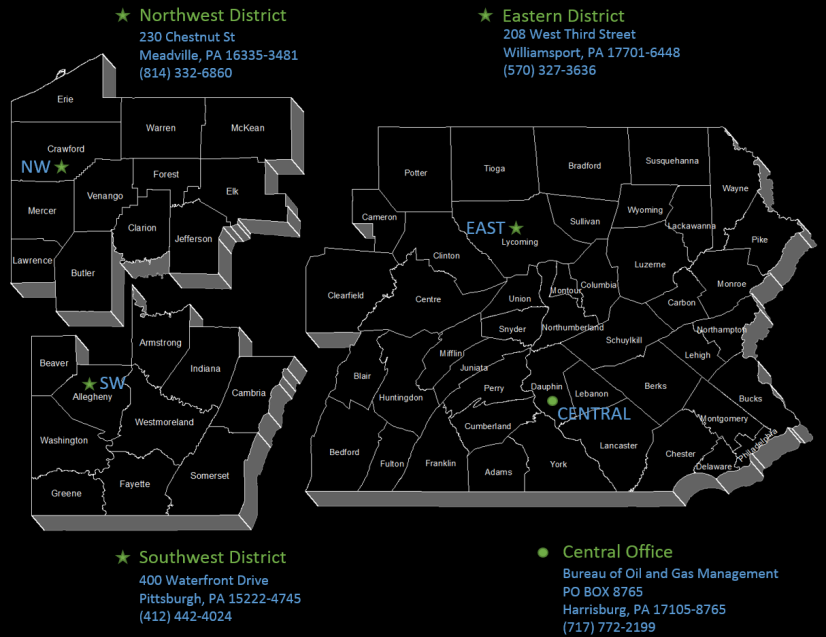
What's Next for 2018
We hope you found this annual report to be informative and useful. This past year was another busy one for DEP, but there is more to be done. DEP and the Office of Oil and Gas Management look forward to continue serving the citizens of Pennsylvania in 2018 through the work that we do to carry out the mission of the Department!
Pennsylvania Department of Environmental Protection
Office of Oil and Gas Management
Key Facts
Complement: 190 employees
Organization: Central Office – Bureau of O&G Planning and Program Mgmt. - Harrisburg
Eastern District Oil and Gas Office – Williamsport
Northwest District Oil and Gas Office – Meadville
Southwest District Oil and Gas Office – Pittsburgh
Funding: Fees, Fines/Penalties and Impact Fee Revenue
Well Drilling Permit Fees: $9,703,101 (FY2016-17)
Orphaned/Abandoned
Permit Fees: $579,100 (FY2016-17)
Penalties: $9,590,432 (FY2016-17)
Impact Fees: $6 million annually
PA Natural Gas Production (unconventional): 5.36 trillion cubic feet
Avg. # Wells Reporting Gas Production (unconventional): 7,794
PA Natural Gas Production (conventional): 96.5 billion cubic feet
# Wells Reporting Gas Production in 2017 (total): 57,461
PA Oil Production (total): 1.1 million barrels
# Wells Reporting Oil Production in 2017 (total): 18,102
Permits Issued:
Unconventional Drilling Permit 2,028
Conventional Drilling Permit 203
Stream Crossing & Encroachment (Individual Permits) 57
Stream Crossing & Encroachment (General Permits) 670
Erosion and Sediment Control General Permit (Expedited) 248
Erosion and Sediment Control General Permit (Standard) 216
Inspections:
Unconventional Inspections 16,296
Conventional Inspections 15,243
Well Site/Administrative Inspections 4,749
Total Inspections 36,288
Violations:
Unconventional 821
Conventional 3,273
Well Site/Administrative 948
Total Violations 5,042
Wells Drilled:
Unconventional 810
Conventional 103
Total Wells Drilled 913
Unconventional (total on record) 10,924
Conventional (total on record) 192,969
# Active Permitted Class II Disposal Wells in PA: 12
# Orphaned/Abandoned Wells in PA (estimated): 100K - 560K
# Orphaned/Abandoned Wells on DEP List (Identified/Ranked) 8,287
# Orphaned/Abandoned Wells Plugged 3,072
NOTE: Unless otherwise specified, all information is reported for calendar year 2017.
Additional Resources
Please visit other DEP Oil and Gas related websites.
Social Media
Use the share button at the top to share this report with others, and click on the buttons below to follow the latest PA DEP activities.

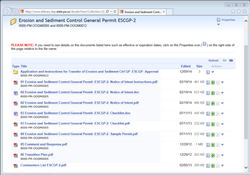 – To construct a well site.
– To construct a well site.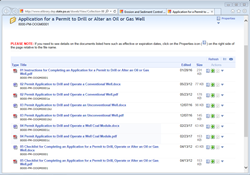 – To drill the well.
– To drill the well. – To build bridges and pipelines that cross waterways.
– To build bridges and pipelines that cross waterways.